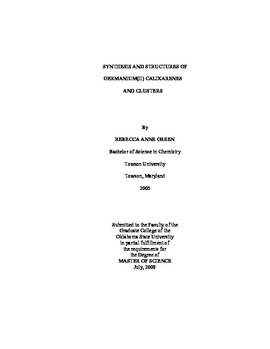| dc.contributor.advisor | Weinert, Charles S. | |
| dc.contributor.author | Green, Rebecca | |
| dc.date.accessioned | 2014-03-14T21:53:36Z | |
| dc.date.available | 2014-03-14T21:53:36Z | |
| dc.date.issued | 2009-07-01 | |
| dc.identifier.uri | https://hdl.handle.net/11244/8080 | |
| dc.description.abstract | The purpose of this work was to examine the structures of novel germanium containing compounds. This was accomplished by characterizing the products of the reaction between the germanium(II) amide, Ge[N(SiMe 3 ) 2 ] 2 , and para-tert-butylcalix[8]arene with subsequent reaction with Fe 2 (CO) 9 . The phenols, HOC 6 H 3 Bu t -2-Me-6, HOC 6 H 4 Bu t -4 and HOC 6 H 3 Bu t -2-Me-4, were selected due to their relative steric bulkiness and were also reacted with Ge[N(SiMe 3 ) 2 ] 2 and the products of the reactions were characterized. Products were characterized by NMR and IR spectroscopy, GC/MS spectrometry and X-ray crystallography. The reaction between para-tert-butylcalix[8]arene and Ge[N(SiMe 3 ) 2 ] 2 yielded the germylene complex {p-Bu t 8 calix[8]arene}Ge 4 and contains two Ge 2 O 2 rhombi located on opposite sides of the molecule. The two rhombi are planar where the Ge - O(terminal) bonds are shorter than the Ge - O(bridging) bonds. Each germanium is in the divalent oxidation state. In the subsequent reaction with Fe 2 (CO) 9 , the Fe - Fe bond was cleaved with addition of Fe(CO) 4 to two of the four germanium atoms with concomitant loss of Fe(CO) 5 . The reaction of Ge[N(SiMe 3 ) 2 ] 2 yielded the monomeric complex Ge(OC 6 H 3 Bu t -2-Me-6) 2 . The reaction with HOC 6 H 4 Bu t -4 yielded the hexagermanium cluster Ge 6 (μ 3 -O) 4 (μ 2 -OC 6 H 4 Bu t -4) 4 that is held together by four μ3-bridging oxo atoms and four μ2-p-Bu t aryloxide ligands. The reaction with HOC 6 H 3 Bu t -2-Me-4 resulted in the formation of two clusters that were structurally characterized. One is the octagermanium cluster Ge8(μ 3 -O) 6 (OC 6 H 3 -Bu t -2-CH 3 -4)4 that is connected together by six μ 3 -oxo atoms with four terminal aryloxide groups. The second structure that was determined was the dimer [Ge 4 (μ-O) 2 (OC 6 H 3 -Bu t -2-CH 3 -4) 4 ·NH 3 ] 2 that contains two Ge 4 O 2 rings that are connected by two Ge - Ge single bonds. The dimer appears to be an intermediate in the formation of the larger octagermanium cluster. All of the germanium atoms are present in the divalent oxidation state. | |
| dc.format | application/pdf | |
| dc.language | en_US | |
| dc.publisher | Oklahoma State University | |
| dc.rights | Copyright is held by the author who has granted the Oklahoma State University Library the non-exclusive right to share this material in its institutional repository. Contact Digital Library Services at lib-dls@okstate.edu or 405-744-9161 for the permission policy on the use, reproduction or distribution of this material. | |
| dc.title | Synthesis and structures of germanium(II) calixarenes and clusters | |
| dc.type | text | |
| dc.contributor.committeeMember | Apblett, Allen W. | |
| dc.contributor.committeeMember | Bunce, Richard A. | |
| osu.filename | Green_okstate_0664M_10466.pdf | |
| osu.college | Arts and Sciences | |
| osu.accesstype | Open Access | |
| dc.description.department | Chemistry Department | |
| dc.type.genre | Thesis | |
| dc.subject.keywords | calixarenes | |
| dc.subject.keywords | clusters | |
| dc.subject.keywords | germanium | |
| dc.subject.keywords | nmr | |
| dc.subject.keywords | phenols | |
